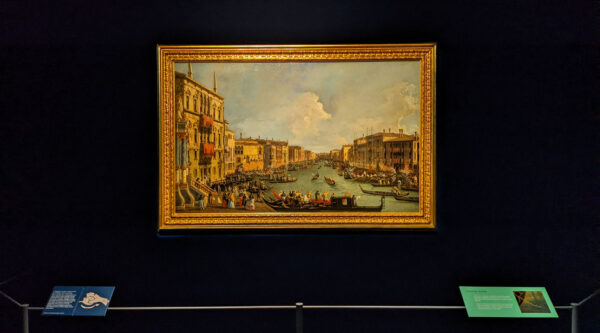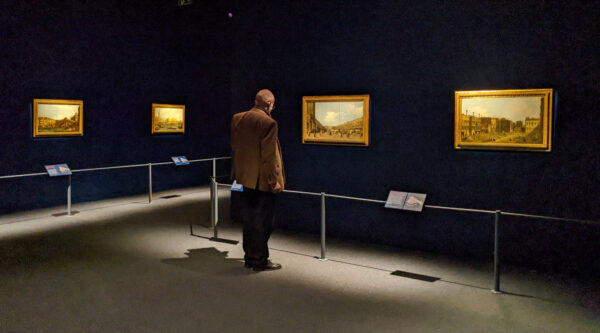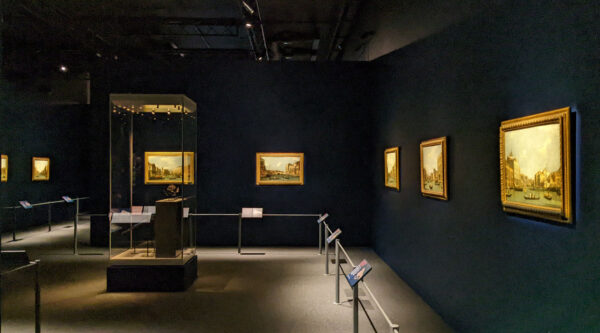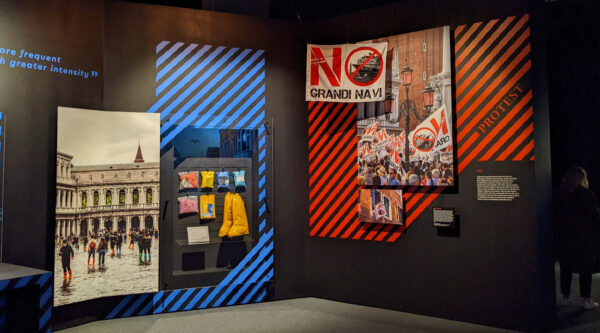Removed from their ancestral home, a complete set of twenty-four classic Canaletto paintings of Venice that have never been seen away from their home have come to London for this exceptionally rare display.
What’s on show are a series of paintings commissioned by Lord John Russell, 4th Duke of Bedford when on his grand tour, and originally displayed at his London home until being moved to Woburn Abbey in the 1790s. Where they have largely remained.
The exhibition is the result of a mansion house being closed for a few years, so Woburn Abbey is lending out many of its best items, and that gives us a unique opportunity to see the Canaletto collection shorn of their decorative surroundings. Displayed in dark rooms with careful lighting on just the paintings, they are now exquisite glowing jewels hanging on the walls for us to admire.
Canaletto’s style and topics are so well known that you can almost point at a Canaletto and know it’s one of his works. This exhibition though is a chance to get really close and see these masterpieces in a way that’s rarely permitted elsewhere.
His paintings were essentially the original postcards collected by tourists, even if at the time, tourists tended to be landed gentry, and the postcards took months to arrive after being paid for. There are short but helpful notes in front of each painting pointing out the key elements of what the painting is showing, a map of where it was set, and some helpful notes about items of interest.
Thanks to that you learn about the curiously shaped chimneys, why Canaletto used to paint boats partially out of the frame, the difference between piazza and campo, that a famous tower in many of his paintings is today a century-old replica after the old one fell down, that dogs held special significance.
There’s also damage. Some paintings show scenes that don’t exist anymore, thanks to the arrival of the railway station to improve connections with the mainland in the 1860s.
As an exhibition, it’s huge picture postcards showing the very best of Venice as it would be remembered by those early travelling nobles. An irony is that to reduce damage to them, tourists are now asked to avoid the famous sights, the very ones we’ve been looking at in this exhibition.
However, as the exhibition reminds us, Venice has gained a reputation as a dying city, with its regular floods and shrinking population, both partially caused by the visitors that fed the city’s economy for the past 70-years since mass tourism arrived.
Venice is sinking, partially because its wooden foundations are sinking faster than usual because of damage caused by large ships and motorboats, but also climate change. Comparing Canaletto paintings that show high tide marks on the stones with modern day views of the same buildings, it’s been estimated that the water level is now 60cm higher than it was when Canaletto was alive.
The population was around 140,000 people when Canaletto was alive, peaked to 175,000 in the 1950s, but has since plunged to just 50,000. Flats are now more lucratively rented to holidaymakers than to residents, and the young priced out are leaving the city.
Cruise ships are a particular focus for the ire of the residents that remain, and the exhibition’s penultimate section looks at how the city is rebelling against these giant monsters of the sea that are totally unsuited to a small lagoon city more used to hand pushed gondolas.
There is a fear that Venice is ceasing to be a functioning city and turning into a historical theme park. The unanswered question is, whether that’s an acceptable fate, after all, theme parks are not intrinsically bad, but can an entire city become one?
The exhibition both opens and ends with one of Canaletto’s more famous paintings, of the annual Festa della Sensa, which takes place on Ascension Day, and saw all the best and grandest boats participating. It was once a major event, but faded over time, only to be revived for the tourists in the 1960s.
What Canaletto painted has been revived as a modern tourist attraction.
If you want to see the Venice of Canaletto, presented for the first time as a dedicated display, this is probably the only time you will ever be able to do so.
The exhibition, Canaletto’s Venice Revisited, is open at the National Maritime Museum from this Friday until late September.
Entry is Adult: £10 | Child: £5 | U-25/student: £6.50
Tickets should be booked from here.
Exhibition Rating
National Maritime Museum
Romney Road, London
SE10 9NF










